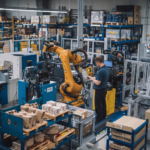Artificial Intelligence (AI) is transforming many areas of human life, from healthcare to finance, and even entertainment. One of the more intriguing—and controversial—applications of AI is its potential to predict wars and conflicts. In a world where political tensions and military actions can escalate quickly, the ability to foresee and possibly prevent conflict could have profound implications for global peace and security. But can AI really predict war?
How AI Could Predict War
At its core, AI is excellent at pattern recognition and processing vast amounts of data quickly. By analyzing historical data on conflicts, political conditions, economic indicators, military movements, and even social media activity, AI systems can identify trends and risk factors that may signal the onset of war. These models are built on the idea that human behavior, including the decision to go to war, follows certain patterns that can be captured, learned, and predicted through data.
Data Collection and Analysis
AI-powered systems collect massive datasets from a variety of sources, such as satellite imagery, economic reports, political speeches, military exercises, and media outlets. Machine learning algorithms then analyze these datasets to identify the conditions that historically precede conflict. These conditions could include economic downturns, political instability, rapid militarization, or even climate-related stresses like droughts or food shortages.
For instance, AI models have been used to analyze past conflicts in regions like the Middle East or Eastern Europe, looking for common indicators that could help forecast future tensions. By correlating factors like military spending, troop movements, and public sentiment, AI can predict potential flashpoints before they escalate.
Social Media and Sentiment Analysis
Social media is another powerful tool for conflict prediction. Platforms like Twitter and Facebook often provide real-time data on public sentiment, unrest, or discontent. AI can process millions of social media posts to gauge the mood of a population or measure political unrest, potentially signaling the early stages of revolution or civil war. Sentiment analysis—where AI assesses the emotional tone of posts—can be an early indicator of rising tensions, particularly in countries with strong social media activity.
AI systems have been developed to monitor social media in conflict zones and detect the spread of propaganda or inflammatory rhetoric, which can be a precursor to violent conflict.
Satellite Imagery and Geospatial Data
Advanced AI technologies can also analyze satellite imagery to monitor military movements or troop build-ups, which could indicate preparation for conflict. Geospatial data, combined with machine learning algorithms, helps track unusual patterns, such as the sudden appearance of military installations, increased border activities, or the displacement of civilians. AI’s ability to process this information more quickly than human analysts can provide early warning of potential conflicts.
Successful Uses of AI in Conflict Prediction
While the idea of predicting war might sound futuristic, there have been some notable successes in AI-driven conflict forecasting. For instance, research teams have used AI models to accurately predict political unrest and civil wars in several countries, including Syria and Ukraine. In 2017, a team at the University of Tokyo created an AI system that successfully predicted the outbreak of violence in parts of Africa based on socio-economic and political data.
Similarly, the U.S. military and intelligence agencies have been working on AI systems for predictive analysis. The Pentagon’s Defense Advanced Research Projects Agency (DARPA) has funded numerous AI projects aimed at predicting conflicts, with the hope that early detection could allow for more strategic decision-making and diplomatic interventions to prevent escalation.
Limitations of AI in Predicting War
While AI shows promise in conflict prediction, it’s far from infallible. War is a complex, multifaceted phenomenon that depends on many unpredictable variables, such as political leadership, sudden provocations, and human decision-making. These factors often defy data-driven models, which rely on historical patterns and quantifiable information.
The Human Element
One major challenge is that AI systems struggle to account for the unpredictable nature of human decisions. Political leaders, generals, or revolutionary groups can make irrational or unexpected choices that are difficult to model. Decisions to start a war are often influenced by personal motivations, emotions, or miscalculations, which are challenging for AI to foresee. For instance, AI might predict tensions in a region, but it may not be able to determine whether a leader will ultimately choose diplomacy or conflict.
Data Gaps and Bias
AI systems rely heavily on the quality and availability of data. In many conflict-prone regions, accurate and up-to-date data may be scarce or manipulated. Governments or insurgent groups might intentionally suppress information, making it harder for AI to predict conflict accurately. Furthermore, bias in the datasets—stemming from cultural, political, or institutional influences—can skew AI predictions.
Ethical Concerns
There are also ethical considerations in using AI to predict war. Should governments use AI predictions to launch preemptive strikes, potentially leading to a conflict that might have been avoided? What responsibility do AI developers and data scientists have in ensuring that their models aren’t misused to justify military aggression? These are critical questions as AI becomes more integrated into national security and defense strategies.
The Future of AI in Conflict Prediction
As AI continues to evolve, its role in conflict prediction is likely to expand. Improved algorithms, better data, and advancements in technologies like natural language processing (NLP) and sentiment analysis will make AI more accurate in identifying the early warning signs of conflict. Moreover, AI could be integrated with other technologies like quantum computing and real-time surveillance to create even more sophisticated models for predicting war.
International organizations like the United Nations and think tanks focused on peace and security are also exploring AI’s potential for conflict prevention. By using AI to predict conflict, these organizations hope to intervene diplomatically or provide humanitarian aid before violence erupts, potentially saving lives and preventing large-scale wars.
Can AI predict war? To some extent, yes. AI can analyze massive amounts of data to identify patterns and risk factors that often precede conflict. It can provide early warnings, allowing governments and international organizations to take preventive actions. However, AI is not perfect, and predicting war remains an inherently difficult task due to the unpredictability of human behavior and the complexity of global politics.
While AI will not replace human judgment in matters of war and peace, it will increasingly serve as a powerful tool for understanding conflict dynamics, helping decision-makers anticipate and mitigate risks before tensions escalate into full-blown wars. The future of AI in conflict prediction holds promise, but it will require careful development, ethical oversight, and international collaboration to ensure its potential is realized without unintended consequences.









